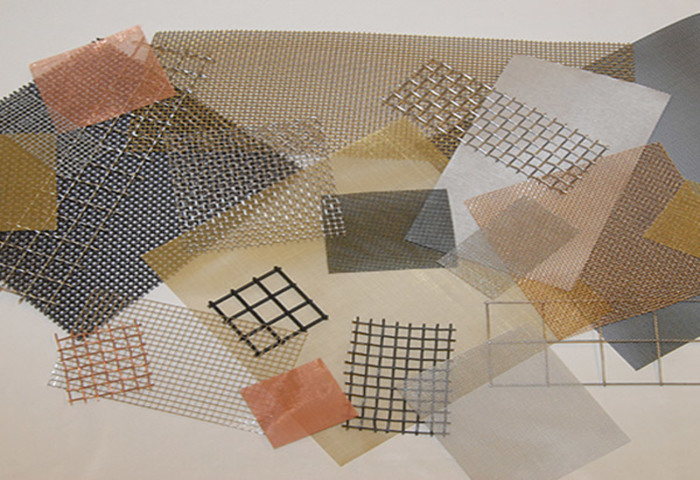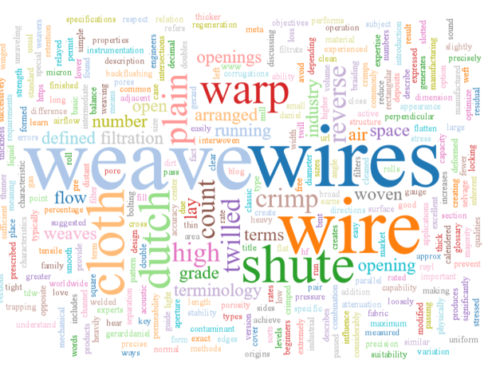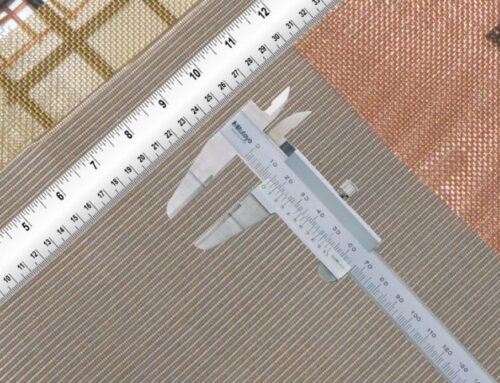Wire mesh, also known as wire cloth, is most commonly woven from stainless steel, however, with the right equipment and settings, almost all metal wire can be woven into a mesh. Below are the properties and features of different alloys and which applications suit them best.
Metals and Alloys
Aluminum
Lightweight, good electrical conductor, and resists atmospheric corrosion; 5056 alloy is used for higher strength.
Brass
Commonly 65% copper/35% zinc. Good formability with lower thermal conductivity and higher tensile strength than copper yet resists corrosion like copper.
Bronze
Most common 90% copper/10% zinc. Better corrosion resistance and lower strength than brass.
Copper
Good formability with excellent electrical and thermal conductivity. Resists corrosion from fresh and saltwater, alkaline solutions, and atmospheric conditions.
Hastelloy® Alloy C-276
Outstanding corrosion resistance in reducing and oxidizing environments. Maintains corrosion resistance in welded condition. Excellent resistance to pitting and stress-corrosion cracking.
Hastelloy® Alloy C-22
Better corrosion than C-276 in select environments. Resistance to a wide range of organic acids and the resistance to chloride-induced SSC, and other reducing chemicals. Also has resistance to some oxidizing environments.
Heat Resisting Alloys
High Nickel copper alloys such as Monel and Inconel can withstand temperatures up to 1800°F and resist corrosion in acids, seawater, and caustic solutions.
Inconel® Alloy 600
High nickel, high chromium content for resistance to oxidizing and reducing environments; for severely corrosive environments at elevated temperatures. Good oxidation resistance to 2150°F. Good formability.
Monel® Alloy 400
High strength, good weldability, excellent corrosion resistance over a wide range of temperatures and conditions.
Nickel
Excellent corrosion resistance in most environments except sulfurous conditions is most commonly used in petrochemical and heat-treating applications.
Nickel 200/201
Commercially pure wrought nickel, good mechanical properties, excellent resistance to many corrosives. Nickel 201 has low carbon (0.02% max.) for applications over 600°F (315°C).
Rare Metals
Tantalum, Molybdenum, Titanium, Silver, Platinum, and others can generally be woven if required. You should reach out to your weaver for more details on their suitability, best weave types, and specific properties.
Plain Steel
Low carbon (C1008) is most commonly used. For high tensile strength and good abrasion resistance, high carbon/hard drawn is recommended.
Stainless Steel
The benefits of stainless steel are that it has high strength, good heat resistance, and resists rusting. Stainless Steel comes in the following types:
Type 304
Type 304 stainless is the basic alloy of this group and is used extensively in the manufacturing of wire cloth. It contains nominally 18% Chromium and 8% Nickel.
Types 304L & 316L
Lower in carbon content, these types are frequently used to retain corrosion-resisting properties after welding.
Type 316
With its addition of 2% minimum Molybdenum, Type 316 provides considerably increased resistance to certain corrosive media. It also provides increased strength at high temperatures.
Type 321
Containing Titanium, it is frequently specified where there is a possibility of sensitization with a resulting loss of corrosion resistance.
Type 347
For most welded assemblies that operate in corrosive environments, Type 347 is used to minimize sensitization. Contains Columbium, which does not volatilize during welding.
Type 430
Type 430 contains 17% nominal Chromium and is more resistant to chemical attack and high-temperature scaling. This alloy is magnetic and is not heat treatable.
Corrosion Resistance of Common Metals
| Chemical vs Metal | Brass | Copper | Inconel | Monel | Nickel | Nichrome | Stainless Steel |
Steel |
| Alcohol | E | E | E | F | G | G | G | G |
| Alkalis | F | X | E | E | E | G | E | E |
| Ammonia | X | X | E | G | F | E | G | G |
| Ammonia Salts | X | X | E | F | F | E | F | F |
| Brine | G | G | E | E | F | G | X | G |
| Cyanide | X | X | G | X | F | E | E | G |
| Hydrochloric | F | X | F | G | F | E | X | X |
| Hydrofluoric | X | F | G | E | F | F | X | X |
| Nitric | X | X | G | X | X | E | E | X |
| Sulfuric | F | F | F | G | F | E | X | X |
NB: The parameters shown in this chart are approximate values only. Your specific application
should not be undertaken without independent study and evaluation for suitability.
Approximate Maximum Operating Temperatures of Metals
| Metal | Temperature (°F) | Temperature (C) |
| Stainless Steel 304 | 1500 °F | 816 C |
| Incoloy | 1600 °F | 871 C |
| Stainless Steel 330 | 1650 °F | 899 C |
| Nichrome | 1700 °F | 927 C |
| Inconel | 1800 °F | 982 C |
| Nichrome V | 2000 °F | 1093 C |
| Nickel | 2700 °F | 1482 C |
| Molybdenum | 4700 °F | 2593 C |
should not be undertaken without independent study and evaluation for suitability.
Conclusion
The above is intended as a guide only to help you select the optimum metal for your application. Virtually all metals can be woven into wire cloth. If you are working on a project and have further questions on which alloy will work best, please reach out to us and one of our experienced engineers will be happy to advise you.



